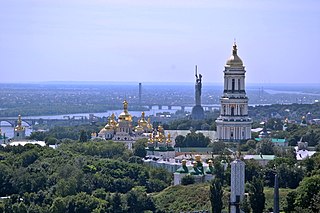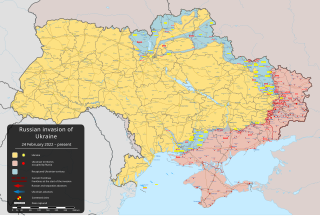
Ukraine used to attract more than 20 million foreign citizens every year. But since 2014 this has lowered to about 10 million. Visitors primarily come from Eastern Europe, but also from Western Europe, as well as Turkey and Israel.

The administrative divisions of Ukraine are under the jurisdiction of the Ukrainian Constitution. Ukraine is a unitary state with three levels of administrative divisions: 27 regions, 136 raions (districts) and 1469 hromadas.

An oblast in Ukraine, sometimes translated as region or province, is the main type of first-level administrative division of the country. Ukraine's territory is divided into 24 oblasts, as well as one autonomous republic and two cities with special status. Ukraine is a unitary state, thus the oblasts do not have much legal scope of competence other than that which is established in the Ukrainian Constitution and devolved by law. Articles 140–146 of Chapter XI of the constitution deal directly with local authorities and their competence.
A raion is a type of administrative unit of several post-Soviet states. The term is used for both a type of subnational entity and a division of a city. The word is from the French rayon, and is commonly translated as "district" in English.

The prosecutor general of Ukraine heads the system of official prosecution in courts known as the Office of the Prosecutor General. The prosecutor general is appointed and dismissed by the president with consent of the Verkhovna Rada. The prosecutor serves a term of office of six years and may be forced to resign by a vote of no confidence in parliament. The current prosecutor general, since 27 July 2022, is Andriy Kostin.
The City of Kyiv has a unique legal status compared to the other administrative subdivisions of Ukraine. The most significant difference is that the city is functionally independent of the oblast (province) in which it is located. That is, Kyiv is subordinated directly to the national-level branches of the Government of Ukraine, skipping the provincial level authorities of Kyiv Oblast, but hosting the administrative and infrastructure bodies for the latter.

The Internal Troops of Ukraine, abbreviated ВВ (VV), were a uniformed gendarmerie and Internal Troops in Ukraine which merged with the National Guard of Ukraine on March 13, 2014. They were subordinate to the Chief Directorate of Ministry of Internal Affairs, and cooperate with the State Emergency Service of Ukraine. The VV were used to assist militsiya in policing, deal with riots and internal armed conflicts, and safeguard important facilities such as nuclear power plants. In wartime, the Internal Troops were under the jurisdiction of the Ukrainian armed forces for local defense and rear area security.

This is a discussion of telephone numbers in Ukraine. The nation of Ukraine has country code +380. It switched to the European Union's common dialing plan in 2009. Thus, Ukrainian phone numbers consist of a 2-digit zone code, an optional subzone code, an optional filler, and the local phone number. However, following the 2022 Russian invasion of Ukraine, the regions of Crimea, Donetsk, and Luhansk were given Russian telephone codes instead, as if they were following telephone numbers in Russia, by Russian authorities.

Izmail Raion is a raion in Odesa Oblast in southwestern Ukraine. Its administrative center is the town of Izmail. It is in the historical region of Budjak in southern Bessarabia. Population: 204,745.

Russian Post has a system of postal codes based on the federal subject a place is located in. Each postal code consists of six digits with first three referring to the federal subject or the administrative division with special status. Some larger subjects have multiple three-digit prefixes. For instance, Moscow's postal codes fall in the range 101–129.

Administrative divisions development in Ukraine reviews the history of changes in the administrative divisions of Ukraine, in chronological order.

During its existence from 1919 to 1991, the Ukrainian Soviet Socialist Republic consisted of many administrative divisions. Itself part of the highly centralized Soviet Union, sub-national divisions in the Ukrainian SSR were subordinate to higher executive authorities and derived their power from them. Throughout the Ukrainian SSR's history, other national subdivisions were established in the republic, including guberniyas and okrugs, before finally being reorganized into their present structure as oblasts. At the time of the Ukrainian SSR's independence from the Soviet Union, the country was composed of 25 oblasts (provinces) and two cities with special status, Kiev, the capital, and Sevastopol, respectively.
In Ukraine, the title chief (head) of local (regional) state administration refers to the chief executive of each of the administrative divisions of Ukraine: region, raion (district) or city, in case of Kyiv and Sevastopol.

A city with special status, formerly a "city of republican subordinance", is a type of first-level administrative division of Ukraine. Kyiv and Sevastopol are the only two such cities. Their administrative status is recognized in the Ukrainian Constitution in Chapter IX: Territorial Structure of Ukraine and they are governed in accordance with laws passed by Ukraine's parliament, the Verkhovna Rada. Most of Ukraine's 27 first-level administrative divisions are oblasts (regions).

The Autonomous Republic of Crimea is an administrative division of Ukraine encompassing most of Crimea that was unilaterally annexed by Russia in 2014. The Autonomous Republic of Crimea occupies most of the peninsula, while the City of Sevastopol occupies the rest.

The 2014 Ukrainian local elections took place on 25 May 2014, four years after the conclusion of the last local elections, which took place in October 2010. The elections occurred during the political crisis in the aftermath of the 2014 Ukrainian revolution.

The Russian-occupied territories of Ukraine are areas of Ukraine that are currently controlled by Russia in the course of the Russo-Ukrainian War. In Ukrainian law, they are defined as the "temporarily occupied territories of Ukraine".











